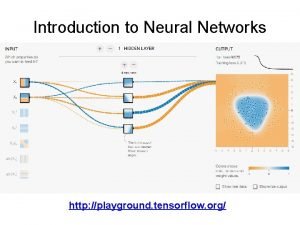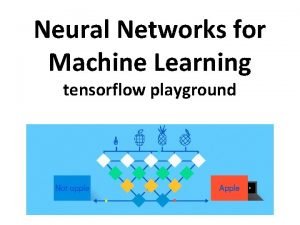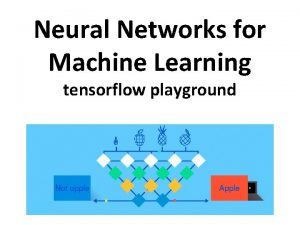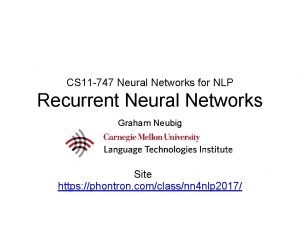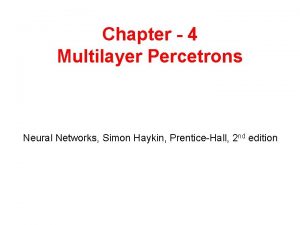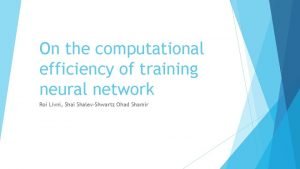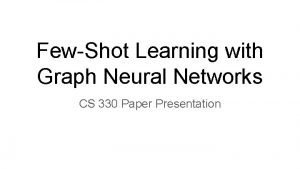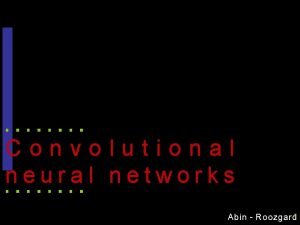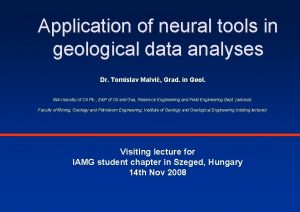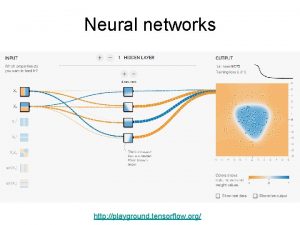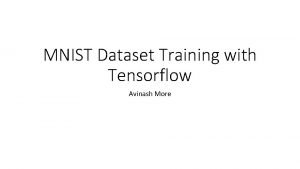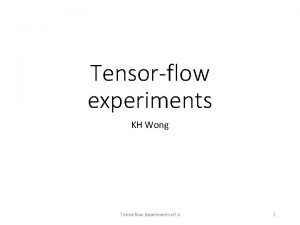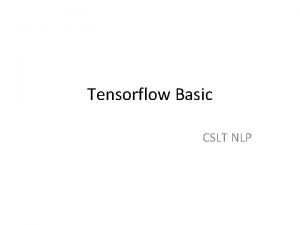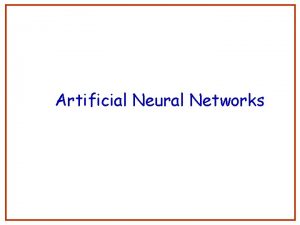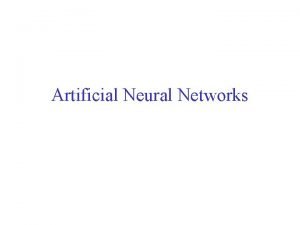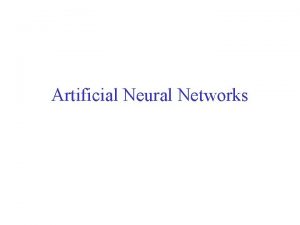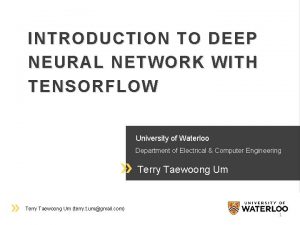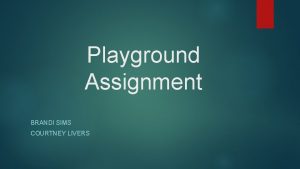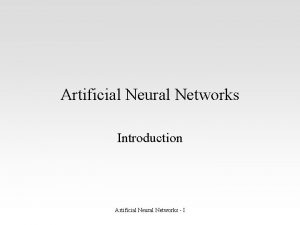Introduction to Neural Networks http playground tensorflow org



























- Slides: 27

Introduction to Neural Networks http: //playground. tensorflow. org/

Outline • Perceptrons • Perceptron update rule • Multi-layer neural networks • Training method • Best practices for training classifiers • After that: convolutional neural networks

Recall: “Shallow” recognition pipeline Image Pixels Feature representation Trainable classifier • Hand-crafted feature representation • Off-the-shelf trainable classifier Class label

“Deep” recognition pipeline Image pixels Layer 1 Layer 2 Layer 3 Simple Classifier • Learn a feature hierarchy from pixels to classifier • Each layer extracts features from the output of previous layer • Train all layers jointly

Neural networks vs. SVMs (a. k. a. “deep” vs. “shallow” learning)

Linear classifiers revisited: Perceptron Input x 1 x 2 x 3. . . x. D Weights w 1 w 2 Output: sgn(w x + b) w 3 w. D Can incorporate bias as component of the weight vector by always including a feature with value set to 1

Loose inspiration: Human neurons


Perceptron training algorithm • Initialize weights w randomly • Cycle through training examples in multiple passes (epochs) • For each training example x with label y: • Classify with current weights: • If classified incorrectly, update weights: (α is a positive learning rate that decays over time)

Perceptron update rule • The raw response of the classifier changes to • If y = 1 and y’ = -1, the response is initially negative and will be increased • If y = -1 and y’ = 1, the response is initially positive and will be decreased

Convergence of perceptron update rule • Linearly separable data: converges to a perfect solution • Non-separable data: converges to a minimum-error solution assuming examples are presented in random sequence and learning rate decays as O(1/t) where t is the number of epochs

Multi-layer perceptrons • To make nonlinear classifiers out of perceptrons, build a multi-layer neural network! • This requires each perceptron to have a nonlinearity

Multi-layer perceptrons • To make nonlinear classifiers out of perceptrons, build a multi-layer neural network! • • This requires each perceptron to have a nonlinearity To be trainable, the nonlinearity should be differentiable Sigmoid: Rectified linear unit (Re. LU): g(t) = max(0, t)

Training of multi-layer networks

Training of multi-layer networks w 1 w 2

Training of multi-layer networks

Network with a single hidden layer • Neural networks with at least one hidden layer are universal function approximators

Network with a single hidden layer • Hidden layer size and network capacity: Source: http: //cs 231 n. github. io/neural-networks-1/

Regularization Source: http: //cs 231 n. github. io/neural-networks-1/

Multi-Layer Network Demo http: //playground. tensorflow. org/

Dealing with multiple classes

Neural networks: Pros and cons • Pros • Flexible and general function approximation framework • Can build extremely powerful models by adding more layers • Cons • Hard to analyze theoretically (e. g. , training is prone to local optima) • Huge amount of training data, computing power may be required to get good performance • The space of implementation choices is huge (network architectures, parameters)

Best practices for training classifiers • Goal: obtain a classifier with good generalization or performance on never before seen data 1. Learn parameters on the training set 2. Tune hyperparameters (implementation choices) on the held out validation set 3. Evaluate performance on the test set • Crucial: do not peek at the test set when iterating steps 1 and 2!

What’s the big deal?

http: //www. image-net. org/challenges/LSVRC/announcement-June-2 -2015

Bias-variance tradeoff • Prediction error of learning algorithms has two main components: • Bias: error due to simplifying model assumptions • Variance: error due to randomness of training set • Bias-variance tradeoff can be controlled by turning “knobs” that determine model complexity High bias, low variance Low bias, high variance Figure source

Underfitting and overfitting • Underfitting: training and test error are both high • Model does an equally poor job on the training and the test set • The model is too “simple” to represent the data or the model is not trained well • Overfitting: Training error is low but test error is high • Model fits irrelevant characteristics (noise) in the training data • Model is too complex or amount of training data is insufficient Underfitting Good tradeoff Overfitting Figure source
 Tensorflow playground github
Tensorflow playground github Tensor flow playground
Tensor flow playground Tensor playground
Tensor playground Toolbox neural network matlab
Toolbox neural network matlab Convolutional neural network presentation
Convolutional neural network presentation Netinsights
Netinsights Visualizing and understanding convolutional networks
Visualizing and understanding convolutional networks Vc bound
Vc bound Cameron mott now
Cameron mott now Audio super resolution using neural networks
Audio super resolution using neural networks Convolutional neural networks for visual recognition
Convolutional neural networks for visual recognition Image style transfer using convolutional neural networks
Image style transfer using convolutional neural networks Efficient processing of deep neural networks pdf
Efficient processing of deep neural networks pdf Mippers
Mippers Least mean square algorithm in neural network
Least mean square algorithm in neural network Lstm components
Lstm components Neural networks for rf and microwave design
Neural networks for rf and microwave design 11-747 neural networks for nlp
11-747 neural networks for nlp Perceptron xor
Perceptron xor Sparse convolutional neural networks
Sparse convolutional neural networks On the computational efficiency of training neural networks
On the computational efficiency of training neural networks Threshold logic unit
Threshold logic unit Neural networks and fuzzy logic
Neural networks and fuzzy logic Convolutional neural networks
Convolutional neural networks Few shot learning with graph neural networks
Few shot learning with graph neural networks Deep forest towards an alternative to deep neural networks
Deep forest towards an alternative to deep neural networks Convolutional neural networks
Convolutional neural networks Neuraltools neural networks
Neuraltools neural networks
